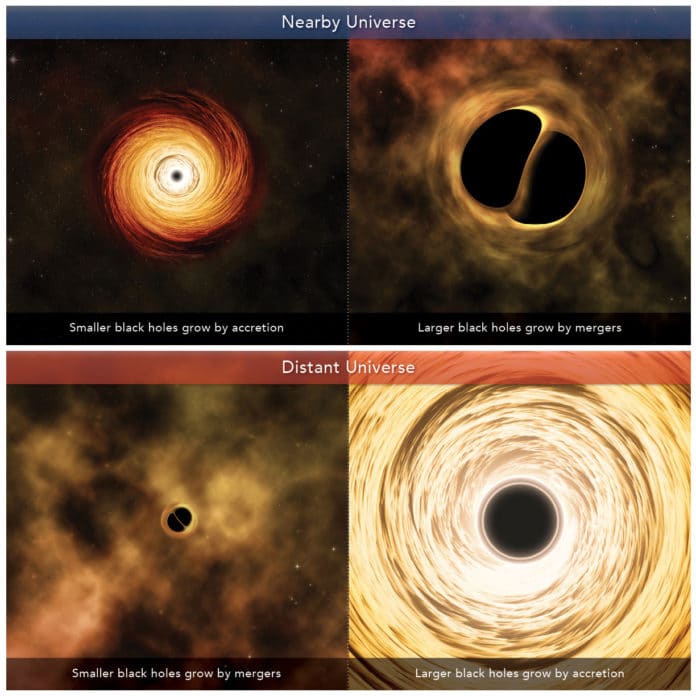The effects of black holes on galaxy evolution are complex and far-reaching. They are ubiquitous and span an extensive range of masses, from stellar-mass to supermassive.
A new study aims to enlighten how black holes grow over time by using a model that tells if growth by accretion or by mergers is dominant. The model is legitimate from the local universe up to redshift 10, or generally from the present day to around 13 billion years back.
Developed by Dr. Avi Loeb, Frank B. Baird Jr. Professor of Science at Harvard, and Dr. Fabio Pacucci, astrophysicist and BHI & Clay Fellow at CfA, the model suggests that the primary growth of the black hole depends on the mass of the black hole and redshift.
In the near universe, small black holes grow for the most part by accretion, while enormous black holes grow for the most part using mergers. In the distant world, there is a reversal: small black holes generally develop by mergers, substantial black holes by accretion.
Dr. Pacucci said, “Black holes can grow in two ways. They can accrete mass from the space around them, or they can merge, forming one more massive black hole. We currently believe that the first black holes started to form approximately with the first population of stars, over 13.5 billion years ago.”
Dr. Loeb said, “The question is: how did these “seeds” grow to form the vast population of black holes that scientists now detect in the universe, from small ones up to the huge monsters that we observe shining from the other side of the cosmos?”
“We can constrain their history not just by detecting light but also through gravitational waves, the ripples in spacetime that their mergers produce.”
Dr. Pacucci said, “Studying the main growth modality of black holes helps to provide us with a clearer picture of how bright these sources can be. We already know that matter falls toward the event horizon of black holes, and, as it speeds up, it also heats up, and this gas starts to emit radiation.”
“The more matter a black hole accretes, the brighter it is going to be; that’s why we’re able to observe far-away objects like supermassive black holes. They’re one billion times more massive than the sun, and they can emit enormous amounts of radiation so we can observe them from even billions of light-years’ distance.”
Loeb further stated that even if their environment is gas-free, black holes can grow in mass through galaxy mergers.”
Pacucci said, “Black holes, and their growth, appear to play a key role in the evolution of galaxies. We believe that every galaxy contains a massive black hole at its center, which regulates the formation of stars in their host. Understanding how black holes formed, grew, and co-evolved with galaxies is fundamental to our understanding and knowledge of the universe, and with this study, we have one more piece of the puzzle.”
“We already tested our model with data from close-by black holes, obtaining very encouraging results. Our goal in this study was to provide the scientific community with a theory that describes how black holes may have grown during the evolution of the universe. This will inform decisions regarding observational strategies with future space telescopes, as well as lay the basis for models that describe other aspects of the evolution of the universe.”
Journal Reference:
- Dr. Fabio Pacucci et al., Separating Accretion and Mergers in the Cosmic Growth of Black Holes with X-ray and Gravitational Wave Observations. DOI: arxiv.org/abs/2004.07246
